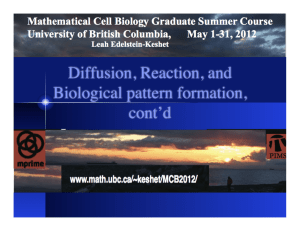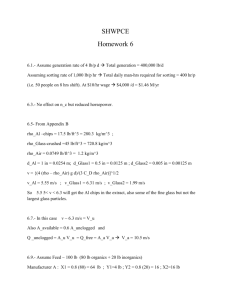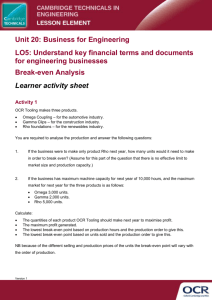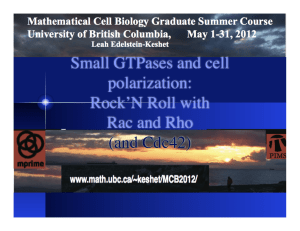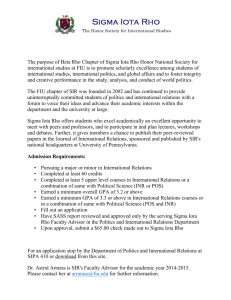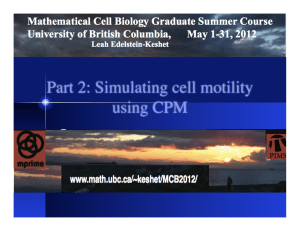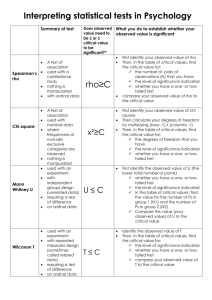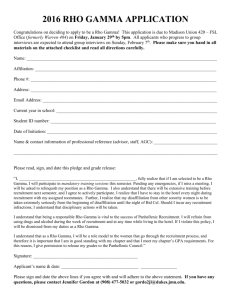Pattern formation of Rho GTPases in single cell wound healing ARTICLE
advertisement
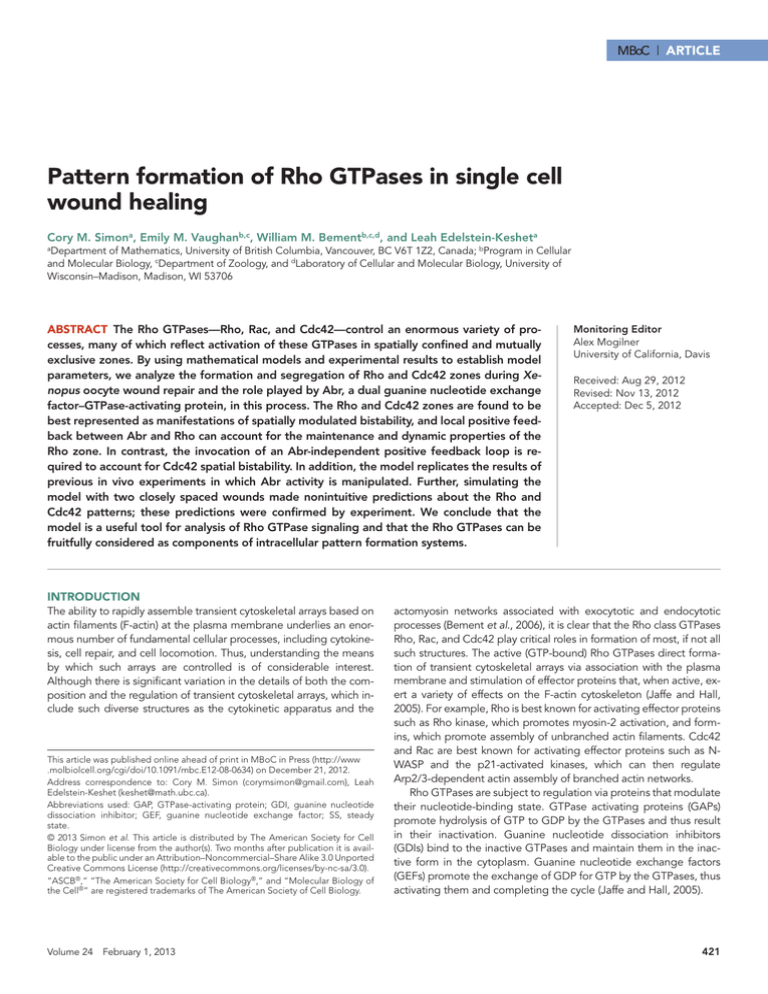
MBoC | ARTICLE
Pattern formation of Rho GTPases in single cell
wound healing
Cory M. Simona, Emily M. Vaughanb,c, William M. Bementb,c,d, and Leah Edelstein-Kesheta
a
Department of Mathematics, University of British Columbia, Vancouver, BC V6T 1Z2, Canada; bProgram in Cellular
and Molecular Biology, cDepartment of Zoology, and dLaboratory of Cellular and Molecular Biology, University of
Wisconsin–Madison, Madison, WI 53706
ABSTRACT The Rho GTPases—Rho, Rac, and Cdc42—control an enormous variety of processes, many of which reflect activation of these GTPases in spatially confined and mutually
exclusive zones. By using mathematical models and experimental results to establish model
parameters, we analyze the formation and segregation of Rho and Cdc42 zones during Xenopus oocyte wound repair and the role played by Abr, a dual guanine nucleotide exchange
factor–GTPase-activating protein, in this process. The Rho and Cdc42 zones are found to be
best represented as manifestations of spatially modulated bistability, and local positive feedback between Abr and Rho can account for the maintenance and dynamic properties of the
Rho zone. In contrast, the invocation of an Abr-independent positive feedback loop is required to account for Cdc42 spatial bistability. In addition, the model replicates the results of
previous in vivo experiments in which Abr activity is manipulated. Further, simulating the
model with two closely spaced wounds made nonintuitive predictions about the Rho and
Cdc42 patterns; these predictions were confirmed by experiment. We conclude that the
model is a useful tool for analysis of Rho GTPase signaling and that the Rho GTPases can be
fruitfully considered as components of intracellular pattern formation systems.
Monitoring Editor
Alex Mogilner
University of California, Davis
Received: Aug 29, 2012
Revised: Nov 13, 2012
Accepted: Dec 5, 2012
INTRODUCTION
The ability to rapidly assemble transient cytoskeletal arrays based on
actin filaments (F-actin) at the plasma membrane underlies an enormous number of fundamental cellular processes, including cytokinesis, cell repair, and cell locomotion. Thus, understanding the means
by which such arrays are controlled is of considerable interest.
Although there is significant variation in the details of both the composition and the regulation of transient cytoskeletal arrays, which include such diverse structures as the cytokinetic apparatus and the
This article was published online ahead of print in MBoC in Press (http://www
.molbiolcell.org/cgi/doi/10.1091/mbc.E12-08-0634) on December 21, 2012.
Address correspondence to: Cory M. Simon (corymsimon@gmail.com), Leah
Edelstein-Keshet (keshet@math.ubc.ca).
Abbreviations used: GAP, GTPase-activating protein; GDI, guanine nucleotide
dissociation inhibitor; GEF, guanine nucleotide exchange factor; SS, steady
state.
© 2013 Simon et al. This article is distributed by The American Society for Cell
Biology under license from the author(s). Two months after publication it is available to the public under an Attribution–Noncommercial–Share Alike 3.0 Unported
Creative Commons License (http://creativecommons.org/licenses/by-nc-sa/3.0).
“ASCB®,” “The American Society for Cell Biology®,” and “Molecular Biology of
the Cell®” are registered trademarks of The American Society of Cell Biology.
Volume 24 February 1, 2013
actomyosin networks associated with exocytotic and endocytotic
processes (Bement et al., 2006), it is clear that the Rho class GTPases
Rho, Rac, and Cdc42 play critical roles in formation of most, if not all
such structures. The active (GTP-bound) Rho GTPases direct formation of transient cytoskeletal arrays via association with the plasma
membrane and stimulation of effector proteins that, when active, exert a variety of effects on the F-actin cytoskeleton (Jaffe and Hall,
2005). For example, Rho is best known for activating effector proteins
such as Rho kinase, which promotes myosin-2 activation, and formins, which promote assembly of unbranched actin filaments. Cdc42
and Rac are best known for activating effector proteins such as NWASP and the p21-activated kinases, which can then regulate
Arp2/3-dependent actin assembly of branched actin networks.
Rho GTPases are subject to regulation via proteins that modulate
their nucleotide-binding state. GTPase activating proteins (GAPs)
promote hydrolysis of GTP to GDP by the GTPases and thus result
in their inactivation. Guanine nucleotide dissociation inhibitors
(GDIs) bind to the inactive GTPases and maintain them in the inactive form in the cytoplasm. Guanine nucleotide exchange factors
(GEFs) promote the exchange of GDP for GTP by the GTPases, thus
activating them and completing the cycle (Jaffe and Hall, 2005).
421 Transient cytoskeletal arrays assemble in discrete locations, and
visualization of active Rho GTPases indicates that this results from
formation of spatially confined activity “zones” at the sites of array
assembly (Bement et al., 2006). Within a given zone, the activity of
the GTPase in question is approximately twofold to fivefold higher
than in regions immediately outside the zones. We henceforth use
“zone” to describe the region where either Rho or Cdc42 is active
beyond basal levels (see also Benink and Bement, 2005; Bement
et al., 2006). A growing body of evidence suggests that the confinement of the zone reflects rapidly local flux of the GTPases through
the GTP cycle (Bement et al., 2005, 2006; Miller and Bement, 2009;
Yoshida et al., 2009; Burkel et al., 2012). The tight localization of the
active GTPases within zones likely permits focal regulation of
GTPase targets, as revealed by comparison of such targets to zones
(e.g., Bravo-Cordero et al., 2011).
Because transient cytoskeletal arrays generally require the spatially and temporally coordinated action of both F-actin and myosin-2, most such arrays entail control by more than one Rho GTPase.
For example, during single cell wound repair, two concentric zones
of Cdc42 and Rho encircle the damaged area (Benink and Bement,
2005). The Cdc42 zone directs formation of a region of highly dynamic actin, whereas the Rho zone directs formation of a region
enriched in active myosin-2. Similarly, during polar body emission—
a highly asymmetric form of cytokinesis—a ring-like Rho zone encloses a patch-like zone of Cdc42 activity (Ma et al., 2006), and,
again, each zone directs formation of a functionally distinct cytoskeletal array (Zhang et al., 2008). Similarly, during cell locomotion,
small, discontinuous zones of Rho and Cdc42 exist, with active Rho
occupying regions from which active Cdc42 and/or Rac are excluded, and vice versa (Machacek et al., 2009). Such segregation is
presumed to result from “cross-talk,” in which the activity of one
GTPase suppresses or enhances the activity of other GTPases either
directly or indirectly (Pertz, 2010). Such positive/negative feedbacks
have been shown to lead to complex temporal dynamics (bistability
or cycles), as well as to spatial gradients and patterns in cells
(Kholodenko, 2006).
Surprisingly, the high degree of spatial precision exhibited by
GTPase zones does not necessarily reflect obviously precise upstream signaling events. For example, during single cell wound repair, an initially crude signal—local elevation of calcium around the
wound (Clark et al., 2009)—is somehow rapidly converted into the
concentric Rho and Cdc42 zones (Benink and Bement, 2005).
To better understand how some of the features of Rho GTPase
zones arise, we chose for analysis the Xenopus oocyte wound repair
model, based on its relative simplicity (see prior discussion) and the
recent observation that the behavior of the GTPase zones during
wound repair is controlled by Abr, a dual GEF-GAP (Vaughan et al.,
2011). In vitro, Abr is a GEF for both Rho and Cdc42 and a GAP for
Cdc42 but not Rho (Chuang et al., 1995). During wound repair,
Abr behaves in a manner consistent with it serving as a GEF for Rho
and a GAP for Cdc42, and it has been proposed to mediate local
cross-talk between Rho and Cdc42 during wound healing (Vaughan
et al., 2011). By using a combination of mathematical models and
experimental results to establish model parameters, we find that
several important features of Rho GTPase pattern formation during
oocyte wound repair can be explained based on the known activities of Abr. We also find that a minimal model not only captures the
results of previous experimental manipulations, but it also accurately
predicts nonintuitive outcomes of new experiments in which wounds
are made at different distances from each other. Finally, the results
support the general notion that the Rho GTPases and their regulators can be considered parts of an intracellular pattern formation
422 | C. M. Simon et al.
system, analogous to the systems that govern developmental
pattern formation.
RESULTS
Evidence for spatial bistability during GTPase
pattern formation
Our first goal was to assess the basic features of GTPase activation
during the oocyte wound response to characterize potential constraints on zone behavior. The behavior of active Rho and Cdc42
was assessed by four-dimensional (4D) time-lapse imaging using
green fluorescent protein (GFP)–rGBD (a probe for active Rho) and
monomeric red fluorescent protein (mRFP)-wGBD (a probe for active Cdc42) as previously described (Benink and Bement, 2005).
Fluorescence intensities in different regions of the cell were measured from 4D image series. Before wounding, the activity of Rho
and Cdc42 is uniformly low over the surface of the cell (Figure 1A)
and remains that way indefinitely unless subject to damage. However, upon wounding, Rho and Cdc42 activity rises to maximal levels
within ∼60–80 s and then reaches a plateau, which is maintained for
∼2–3 min, after which time the zones move z-ward (i.e., toward the
cell interior) and can no longer be followed (Figure 1A). Over the
same time period, regions outside the zones maintain background
levels of Rho and Cdc42 activity (Figure 1, B and C). With known
rates of GTPase diffusion and inactivation/GDI sequestering (Postma
et al., 2004), these regions of high activity would be expected to
decay over this time scale without a mechanism for sustaining them.
These behaviors are reminiscent of “spatial bistability.” Bistability
denotes the existence of both low- and high-activity states in a timedependent system, with some threshold separating the two states.
Spatial bistability refers to spatially distributed systems in which the
activity or abundance of a given pattern regulator is high within a
limited spatial zone and at background levels elsewhere (e.g., Wang
and Ferguson, 2005), with some transition layer connecting these
regions (Goehring et al., 2011). Such regions often develop progressively, with an initially shallow gradient becoming sharper over time,
as observed here in the RhoA and Cdc42 activity in Figure 1, B and
C. Often spatial bistability results when bistable reaction kinetics are
coupled with spatial diffusion of the reactants. The presence of a
threshold in bistability implies that a perturbation must be large
enough to switch the system from one state to another (Goehring
et al., 2011). This characteristic is necessary to avoid the formation
of spontaneous regions of activity from small, random fluctuations in
an unwounded cell. A common theme in chemical systems that engender bistability is a positive feedback loop (Ferrell and Xiong,
2001), such as the one between RhoA and Abr, but other mechanisms for bistability are possible (Craciun et al., 2006).
Cross-talk during GTPase pattern formation
We next compared spatial patterns of active Rho and Cdc42 to
each other. To accomplish this, we generated kymographs from
10-pixel-wide slices through one side of the wound (Figure 2A)
and converted them into double-label line-scan intensity plots
(Figure 2B and Supplemental Movie S1). The kymograph and
plots make evident what is difficult to see in the time-lapse series
shown in Figure 1: Although active Rho and Cdc42 ultimately segregate into discrete zones, initially their activity is more broadly
distributed and in fact shows significant overlap (Figure 2B). However, between ∼30 and 70 s, coincident with the sharp rise of Rho
and Cdc42 activity (see Figure 1B), as Rho activity rises and resolves into a sharper peak, the peak of local Cdc42 activity that
initially overlapped with it is lost in that region and accumulates
behind it (relative to the wound; Figure 2B). Thus the GTPase
Molecular Biology of the Cell
FIGURE 1: Basic features of GTPase response to wounding. (A) Time course showing individual frames generated from
a 4D movie of active Rho (green) and active Cdc42 (red) during oocyte wound response. Each frame represents a
projection of six optical sections. Time after wounding in minutes:seconds. (B) Plot of fluorescence intensity of GFPrGBD (RhoA activity) within the zone at different times after wounding and intensity at regions 10 μm outside the zone.
Each point represents an average of eight measurements taken at different positions within or outside the zone. The
positions of the zone (and thus the measurements) were determined from line intensity scans and thus represent
moving frames of reference. (C) Plot of fluorescence intensity of RFP-wGBD (Cdc42 activity) within the zone at different
times after wounding and intensity at regions 10 μm outside the zone. Each point represents an average of eight
measurements taken at different positions within or outside the zone as in B.
zones are not initially separate but arise from regions of overlapping and relatively low Rho and Cdc42 activity. This progressive
amplification and segregation resembles processes observed in
developmental pattern formation, which are often underlain by
both positive and negative feedback between signaling molecules (see Discussion).
Basic models
The foregoing results provided an empirical framework with which
to test different models designed to account for zone behavior. We
developed a reaction-diffusion-advection model to analyze the processes of zone maintenance and segregation and the ability of the
dual GEF-GAP Abr to account for the observed behaviors of the
zones. Treatment of Rho GTPases using reaction-diffusion-advection
equations naturally follows from their known diffusion properties
and interactions.
The models are based on the following assumptions: 1) Local
barriers to diffusion are not needed. Thus the system is treated
strictly in terms of activation, inactivation, cross-talk, and feedback between GTPases and GEF/GAPs/GDIs. This assumption is
based on the observation that there are no apparent physical
structures between the zones, as well as on the fact that zones
Volume 24 February 1, 2013
form and segregate after the disruption of either F-actin or
microtubules (Benink and Bement, 2005). 2) Abr has GEF activity
toward Rho and Cdc42 and GAP activity toward Cdc42 but not
Rho. This assumption is based on direct in vitro measurements of
the GEF and GAP activity and specificity of Abr (Chuang et al.,
1995). 3) Abr is targeted to wounds via interaction with active
Rho. This assumption is based on the demonstration that Abr
targeting to wounds requires active Rho and that exogenously
activated Rho recruits Abr to the plasma membrane in unwounded cells (Vaughan et al., 2011). 4) Wounded plasma membrane is not capable of supporting Rho GTPase activity and thus
defines the maximum inner limit of the GTPase zones. This assumption is based on the observation that the centers of wounds
do not have active Rho or Cdc42 (Benink and Bement, 2005) or
phosphatidylserine (unpublished results), a normal lipid component of the plasma membrane.
Three interrelated models were developed and sequentially
tested (Figure 3). In Model 1, just the Abr–Rho module is considered, in which Abr serves as a GEF for, and undergoes positive
feedback with, Rho. In Model 2, the Abr–Rho module and Cdc42
are considered, in which the Abr serves as both a GAP and a GEF
for Cdc42. In Model 3, the Abr–Rho module and Cdc42 models
Rho GTPase pattern formation | 423 FIGURE 2: Segregation of the Rho and Cdc42 zones. (A) Data kymograph of 10-pixel-wide slices from a movie used to
generate Figure 1A, showing active Rho (green) and active Cdc42 (red). Here t is time in seconds, r is distance from the
wound center (spans 40 μm), and the wound is toward the left of the kymograph. The first, second, and third tick marks
indicate the time of wounding, the initial condition (time zero) for the model, and the final simulation time, respectively.
(B) Plots of intensity profiles (data) of probe for active Rho (green) or active Cdc42 (red) corresponding to slices
presented in A. Dashed line represents the wound edge.
are considered together with the addition of a positive feedback
loop for Cdc42. For all models, Rho and Cdc42 are considered
to be in flux on and off the membrane, with the active form associated with the membrane and the inactive form in the cytoplasm (Figure 3A), and all models incorporate myosin-2–powered advection. Note that we do not explicitly track or model
myosin or actin. Instead we assume a flow of cortex (and membrane-associated GTPases) toward the wound center. The radial
profile of the flow velocity is constrained by the continuity equa-
A
tion, and we fit the magnitude to wound location data. For each
reaction shown in Figure 3, we assume a simple mathematical
description and only modify that if necessary. The models focus
on the period of time during which the overlapping, shallow Rho
and Cdc42 activity gradients are converted into steep, mutually
exclusive zones. This corresponds to the ∼48- to ∼78-s interval
after wounding in the typical cell (see Figure 2); for the sake of
convenience 48 s after wounding is considered time zero for the
model.
Spatial bistability of the RhoA–Abr
module requires nonlinear kinetics
B
Plasma Membrane
G*
Model 1
Model 3
GTP
RhoA*
GTP
IG
Model 2
RhoA*
GTP
RhoA*
GTP
AG
Abr
GDI
GEF
GAP
Abr
GEF
Abr
GAP
GEF
GAP
G
GDP
Cdc42*
GTP
Cdc42*
GTP
FIGURE 3: Models of GTPase pattern formation. (A) Schematic showing the basic scheme of
Rho or Cdc42 association with the plasma membrane. (B) Schematic showing the three basic
models generated and tested in this study. Model 2 contains proposed interactions based on
experiments, and Model 3 contains a positive feedback loop for Cdc42 postulated by our
model.
424 | C. M. Simon et al.
We first tested Model 1 to assess the hypothesis that the bistability can arise from
RhoA–Abr interactions independent of the
Cdc42 module, as indicated by empirical
results (Vaughan et al., 2011; see the Supplemental Material, Section S2.1). The activation rate of Rho (Afree rho) includes a constant term to represent Rho GEFs other than
Abr and a term that is an increasing function
of Abr to represent the GEF activity of Abr.
The binding of Abr to active Rho is modeled
with mass action kinetics. When Afree rho depends linearly on localized Abr, bistability is
not achieved and Rho has only one steady
state (Figure 4A). Similarly, when the relationship between Afree rho and localized Abr
are represented by Michaelis–Menten kinetics, bistability cannot be achieved (Figure
4B). In contrast, if a Hill function (i.e., sigmoidal kinetics) is used for the relationship
between Afree rho and localized Abr, spatial
Molecular Biology of the Cell
FIGURE 4: Model 1 simulations of RhoA activity and Abr vs. distance from the center of the wound. (A) Linear kinetics
for the Abr-mediated activation of Rho result in any stimulus of RhoA or Abr decaying to the background level for all
parameter regimes. (B) Michaelis–Menten kinetics fail to sustain the pattern as well. (C) A Hill function for the Abrmediated Rho activation results in the sustenance of the Rho pattern, as observed in vivo.
bistability is achieved, with two stable steady states being observed
for a certain parameter range (Figure 4C). On the basis of this nonlinear form of Afree rho, the reaction terms fabr-rho and ffree rho result in
a situation in which the rates of activation (A) and inactivation (I) can
be stably balanced in two different states, yielding for Rho and Abr
both a low and a high steady state far and near the wound, respectively. In other words, if the kinetics between the interactions of Rho
and Abr are sufficiently nonlinear, the system is endowed with bistability, which explains how high levels of Rho activity can be maintained in a narrow region. (Compare Figure 4 to Figure 1B.)
Spatial bistability of Cdc42 requires positive feedback
and nonlinear kinetics
We next sought to incorporate Cdc42 into the results by testing
Model 2 (see Figure 3 and the Supplemental Material, Section S2.2),
building upon the successful model for the Rho–Abr module that
invoked sigmoidal activation kinetics. To account for the other (non
Abr) GEFs and GAPs that we do not explicitly model, we included a
constant term in both Acdc and Icdc. We model the GEF and GAP
activity of the localized Abr with simple, mass action kinetics (linear
terms with respect to Abr-bound RhoA) in Acdc and Icdc. Under these
assumptions (Model 2), the model fails to account for the observed
Cdc42 peak and instead results in any Cdc42 activity decaying to its
basal level (Figure 5A). Mathematically, this is due to a lack of bistability. Both linear and nonlinear kinetics for Abr regulation of Cdc42
were insufficient to capture spatial bistability (see the Supplemental
Material, Section S2.2). Because Cdc42 maintains two disparate
activity levels outside of the RhoA zone, where Abr is at a uniform
level, any nonlinearity in the Abr regulation of Cdc42 or interaction
with free active RhoA cannot possibly account for two disparate
steady states outside of the RhoA zone.
Accordingly, we developed Model 3, which invokes Cdc42dependent, Abr/Rho-independent positive feedback (Figure 3).
Three versions of Model 3 were tested: one in which the Cdc42
Volume 24 February 1, 2013
autocatalysis was assumed to have linear kinetics, one in which it
was assumed to have Michaelis–Menten kinetics, and one in which it
was assumed to have Hill kinetics. As observed with Rho, linear kinetics (Figure 5B) or Michaelis–Menten kinetics (unpublished data) failed
to reproduce Cdc42 bistability, whereas Hill kinetics successfully captured the required bistability (Figure 5C; Supplemental Movie 1).
Further, comparison of the patterns of changes observed in the Rho
and Cdc42 profiles over time in the model paralleled those observed
in vivo. Specifically, the initial overlap of broad Rho and Cdc42 gradients is rapidly converted into mutually exclusive, concentric zones,
with the Cdc42 zone outside (i.e., distal to the wound) and the Rho
zone inside (i.e., proximal to the wound). As expected, based on the
results presented, the segregation occurs spontaneously from the
initial conditions when all of the features of Model 3 are present but
fails in simpler models when one or more of the proposed interactions are lacking (Figures 4, A and B, and 5, A and B).
Comparison of the in silico model to Abr manipulations
in vivo
To further assess the experimental fidelity of Model 3, we systematically compared results of previous in vivo experiments to model
simulations of those experiments.
In the first experiment, with overexpression of wild type Abr, the
Rho zone broadens to approximately twice its normal width while
maintaining a normal level of intensity as the concentration of Abr is
successively increased (Vaughan et al., 2011). Meanwhile, the Cdc42
zone decreases in intensity and is overtaken by the Rho zone
(Vaughan et al., 2011). We mimicked this manipulation in silico by
increasing the value of the cytosolic Abr concentration, [A]. After this
manipulation, Model 3 captures both the loss of the Cdc42 zone
and the spreading of the Rho zone without a significant increase in
intensity (Figure 6A and Supplemental Material, Section S6.1).
The model, however, predicts that, at the highest levels of Abr
overexpression (22% above normal background cytosolic levels),
Rho GTPase pattern formation | 425 FIGURE 5: Model 2 and 3 simulations of Cdc42 activity vs. distance from the center of the wound. We use the
RhoA–Abr Model 1 described earlier. (A) Simulation of Model 2. For every parameter regime and any stimulus of Cdc42,
any Cdc42 activity outside of the RhoA zone will decay to the background level without positive feedback for Cdc42.
(B) Model 3 with a linear form of Cdc42 autocatalysis fails to capture the maintenance of the Cdc42 zone. (C) Model 3
with a Hill-function representation of Cdc42 autocatalysis results in the sustenance of the Cdc42 peak, as observed in
vivo. The experimental intensity profiles from Figure 2B are plotted as points with the final Model 3 simulation. The
simulated (solid) and experimental (dashed) wound edge is indicated with the black, vertical line.
the Rho zone will fill the entire field, as the Rho–Abr system is unable
to attenuate the positive feedback in the low steady state and becomes monostable only with the high steady state. Although this is
likely due to the mathematical assumptions (constant cytosolic concentrations, mass action binding of Rho to Abr) breaking down, a
potential biological explanation for this discrepancy is that the trailing edge of the Rho zone can direct the recruitment of a GAP that
limits the spread of the Rho zone, a possibility not modeled in the
present study but consistent with findings from previous work (Burkel
et al., 2012). It is also formally possible that higher levels of Abr expression than those achieved in the experimental study of Vaughan
et al. (2011) might produce the predicted global Rho activation.
In the next experiment, involving the expression of a GEF-dead
Abr mutant that nonetheless localizes with active Rho, the Cdc42
zone collapses and the Rho zone is greatly attenuated (Vaughan
et al., 2011). We mimicked the loss of GEF activity in this manipulation by decreasing the parameters k1 and k5, which govern Abrmediated activation in Afree rho and Acdc, and we mimicked the
effects of overexpression by increasing [A]. After this manipulation,
both the RhoA and Cdc42 zones fail to form with a sufficient decrease in k5 and increase in [A] (Figure 6B and Supplemental Material, Section S6.2). The Rho zone collapses because the positive reinforcement mechanism is not present with GEF-dead Abr. The Cdc42
zone collapses because of two factors: an increase in the level of the
Cdc42 GAP activity due to overexpression of the mutant (which still
has Cdc42 GAP activity) and the loss of Cdc42 GEF activity.
In the next experiment, involving the expression of a GAP-dead
Abr mutant that nonetheless localizes with active Rho, both the Rho
and Cdc42 zones persist, but they broaden and bleed into each
other (Vaughan et al., 2011). We mimicked this manipulation by
decreasing k8, the model parameter that represents Abr-mediated
426 | C. M. Simon et al.
inactivation of Cdc42. As in the GEF-dead mutant manipulations,
overexpression was mimicked by increasing [A]. For modest changes
(75% for k8 and 20% for [A]), the model results in broadening of the
Rho and Cdc42 zones and their bleeding into each other, consistent
with the in vivo results (Figure 6C and Supplemental Material, Section S6.3). For more extreme changes in parameters, the system
cannot attenuate the positive feedback from Abr overexpression
and maintains only the high steady state. For Cdc42, this in silico
experiment is sensitive to parameter changes because the increased
levels of activation due to Abr (which still has its GEF domain) overexpression is exacerbated by the loss of the ability of Abr to inactivate Cdc42.
In the next experiment, involving the microinjection of C3 exotransferase, which specifically and irreversibly inactivates Rho, Abr
is not recruited (Vaughan et al., 2011), the Rho zone fails to form,
and the Cdc42 zone broadens and increases in intensity (Benink and
Bement, 2005). We mimicked this manipulation by decreasing the
Rho activation terms k 0r and k1. Consistent with the in vivo results,
the Rho zone fails to form, Abr is not recruited, and the Cdc42 zone
increases in intensity and broadens (Figure 6D and Supplemental
Material, Section S6.4). The results can be understood based on the
following model features: Rho inhibition results in less Abr recruitment, simultaneously reducing Icdc and Acdc. Owing to the relative
strengths of these activities, the Cdc42 module retains its bistable
property, and the steady-state value of Cdc42 within the zone is
elevated.
To visualize the model predictions graphically, we plotted phase
portraits of the Abr–Rho (two-equation) system and of the (single)
Cdc42 dynamics in Figure 7. Curves shown in green-black are, respectively, the Rho and Abr nullclines in the Abr–Rho plane, whose
intersections are steady states. These are not to be confused with
Molecular Biology of the Cell
FIGURE 6: In silico experiments to recapitulate in vivo results. (A) To model WT Abr overexpression, [A] is increased by
20%. The RhoA zone broadens to overtake the Cdc42 zone but does not significantly increase in intensity. (B) On
overexpression of GEF-dead Abr, the RhoA and Cdc42 zones cannot be sustained. (C) On overexpression of GAP-dead
Abr, the zones overlap and broaden in comparison to controls. (D) On C3 inactivation of RhoA, the Cdc42 system retains
its bistable property and its pattern still forms. The Cdc42 activity zone brightens due to an elevated high steady state
and broadens since the Rho zone is not present to suppress it in the region closer to the wound.
Volume 24 February 1, 2013
Rho GTPase pattern formation | 427 FIGURE 7: Model phase portraits reveal the effect of in silico experiments on the number and values of steady states.
Left, Abr–Rho phase plane showing active Rho (green) and Abr (black) nullclines. Steady states (SS) are at points of
intersection. For comparison, SS Rho activity levels for the controls are indicated with horizontal lines. Red diagrams,
dC*/dt vs. C* (where C* = active Cdc42), showing rate of activation (solid) and inactivation (dotted) (SS Cdc42 activity
levels for controls are indicated by the vertical lines.) Top, “control” (WT) simulations. Second row, WT Abr
overexpression (as in Figure 6A). Third row, GEF-dead Abr (as in Figure 6B). Fourth row, GAP-dead Abr (as in Figure 6C).
Last row, C3 Rho (as in Figure 6D). Note the disappearance and/or shifting steady-state values in the distinct
treatments. Also note the higher turnover rates inside the Rho zone by comparing the ordinates in columns 1 and 2.
the Cdc42 rate balance plots (red), where both the activation rate
(solid red) and the inactivation rate (dotted red) curves depict dC*/dt
versus C* (where C* is active Cdc42 level). Steady states are also at
intersections of these curves, where activation and inactivation of
428 | C. M. Simon et al.
Cdc42 are balanced. Cdc42 dynamics depend on Rho and Abr levels, and thus have distinct shapes inside and outside the woundpatterning zone, as shown. From such plots, we can understand
how manipulations described in this article affect model properties
Molecular Biology of the Cell
pattern zone width. We first show a control
(WT) case: Both Rho–Abr and Cdc42 “outside zone” have three steady states (the
middle one is unstable), a hallmark of bistability. Cdc42 has but one lower-activity
steady state inside the zone (monostability)
due to distinct self- and Abr-induced activation/inactivation rates in the zone environment. The single, low steady state of Cdc42
inside the Rho zone explains why the Cdc
zone does not overlap the Rho zone. In WT
Abr overexpression, the threshold for Rho
drops, broadening the Rho zone. Rho intensity is scarcely affected, due to its saturating
activation rate. Cdc42 is bistable outside
but monostable inside the Rho zone (a single steady-state activity level). Consequently the Cdc42 zone contracts not because its threshold is lower but because
expansion of the Rho zone suppresses
Cdc42 in the region where Cdc42 would
normally be present. In both GEF-dead Abr
and C3 Rho, Rho–Abr is monostable at low
levels, whereas Cdc42 is bistable in the latter but not the former case. This explains
why the Cdc42 zone survives in the C3 Rho
experiment but not in the GEF-dead Abr experiment. Although the threshold for Cdc42
during C3 Rho is not lower than in controls,
the zone still broadens because the Rho
zone is not there to suppress Cdc42 in the
region closer to the wound. For GAP-dead
Abr, the Rho zone resembles the WT Abr
overexpression case, but the bistable Cdc42
has a much smaller threshold (inside the
zone) and a higher (single) steady-state level
inside the Rho zone, resulting in a broader
Cdc42 zone that appears to overlap with the
Rho zone.
Making and testing spatial predictions
with the model
Given that spatial relationships are at the
heart of pattern formation, we next sought
FIGURE 8: Two wound simulations (bottom) and experiments (top). (A) When the wounds are far
to determine whether the model could be
apart (35 μm in silico), they behave independently. (B) When the wounds are very close (1 μm in
harnessed to predict the consequences of
silico), they behave as a single wound surrounded by single oval-shaped zones of Rho and Cdc42.
experimentally manipulating the spatial re(C) When wounds are close enough for the initial Rho gradients to overlap (20 μm in silico), the
Rho zones between the wounds fuse together to create a zone wider than twice the width of that lationships of zones with each other. The
most straightforward manner to accomplish
in a single control wound. The Rho recruits enough Abr to suppress the Cdc42 in this region with
its GAP domain. (D) When wounds are close enough to have overlapping Cdc42 gradients but not this is to generate multiple wounds at different distances from each other such that
significantly overlapping Rho gradients (26 μm in silico), the Cdc42 zones between the wounds
fuse together to create a zone more than twice the width of that in a single control wound.
zones are well separated, in close proximity,
or overlapping. To investigate these manipand, in particular, the number of steady states, the presence or abulations in silico, we simulated Model 3 in two-dimensional space
sence of bistability, and the values of steady-state GTPase intensity
(see Materials and Methods) where two wounds are proximal to one
levels. In particular, the difference between the lowest two steady
another with additive initial stimuli.
states represents the “threshold” that has to be breached to switch
Four sets of simulations were run (Supplemental Material, Secthe system to its locally high GTPase-activity state. For a fixed initial
tion S7): those in which the distance between the wounds, L, was
gradient from the wound center, a low threshold means that a large
relatively large (35 μm), moderate (26 μm), small (20 μm), or very
region will be induced (by bistability) to jump to a high-activity
small (1 μm). Not surprisingly, at large distances, paired wounds besteady state. (Conversely, a higher threshold decreases the region
haved like single wounds, each encircled by one Cdc42 zone and
so induced.) This links steady-state levels and threshold size to
one Rho zone (Figure 8A), a prediction that matches the behavior
Volume 24 February 1, 2013
Rho GTPase pattern formation | 429 observed in vivo (Figure 8A). Conversely, the model predicts that
two very closely spaced wounds behave as a single wound, with the
pair of holes becoming surrounded by a single set of zones, oval in
shape (Figure 8B). Again, this prediction was matched by the in vivo
result (Figure 8B).
However, between these two extremes, somewhat less intuitive
results were predicted by the model. For paired wounds separated
by a distance expected to result in overlapping of the Rho and the
Cdc42 zones of adjacent wounds, the model predicted local annihilation of the Cdc42 zones by the Rho zones, such that two fused,
ring-like Rho zones would be encircled by one approximately oval
Cdc42 zone (Figure 8C). This predicted behavior was matched by
the in vivo results (Figure 8C). This result is explained by recruitment
of Abr to regions where Rho and Cdc42 are expected to overlap;
Abr, once recruited, inactivates Cdc42 in this region.
Even less intuitive was the prediction for wounds positioned
such that their Cdc42 zones were expected to be close (within ∼5–
10 μm) but not touching. The model predicted that in such cases,
the two Cdc42 zones should reach across the space separating
them and fuse (Figure 8D). Remarkably, this prediction too was confirmed by the in vivo results (Figure 8D). This result is explained
by the stimuli from the two adjacent wounds adding together to
breach the threshold concentration over a greater spatial extent
between the wounds, yielding a fused zone wider than twice the
width of single zones in controls.
DISCUSSION
Several specific findings emerge from the combined use of modeling and experiments in this study. The first is that the known interactions of Rho and Abr, if mediated by sufficiently nonlinear kinetics,
are sufficient to explain the formation and maintenance of two spatially distinct activity levels, that is, the spatial bistability observed in
this system. The second is that whereas the exclusion of active
Cdc42 from the Rho zone can be explained by features of Abr, a
nonlinear self-catalysis mechanism for Cdc42 activity control must
be invoked to account for the observed bistability of the Cdc42. The
third is that the models predict that the turnover rate of the GTPases
is higher within the zones than in regions outside the zones, a finding that is initially counterintuitive but consistent with previous theoretical (Bement et al., 2006) and empirical (Burkel et al., 2012)
observations.
Previous results obtained by analysis of the role of the dual GEFGAP Abr provide the basis for positive feedback within the Rho
zone: an initially shallow gradient of Rho activity would be autoamplified by the recruitment of Abr to the nascent Rho zone, where Abr
would promote further Rho activation and thus further Abr recruitment (Vaughan et al., 2011). How might nonlinear kinetics be incorporated into this scheme of feedback? Although the answer to this
question awaits further analysis, potential explanations include increases in Abr Rho GEF activity due to plasma membrane targeting
(e.g., Wang et al., 2006), increased Rho GEF activity due to association of Abr with active Cdc42 via its GAP domain, or even increased
Rho GEF activity due to association of active Rho via its GAP
domain.
In the eventual Model 3, we chose a sigmoidal dependence of
Cdc42 activation on Cdc42 activity level. To some extent, this choice
(and detailed decisions about the nonlinear forms of the feedback
terms) is arbitrary. It has been shown (Jilkine et al., 2007, Appendix
A; Kholodenko 2006) that various forms of positive feedback on
GEFs are equivalent to negative feedback on GAPs, and that simultaneous Michaelian dependences on GTPase in both GEF and GAP
rates also produce bistability (Kholodenko 2006). Linear terms do
430 | C. M. Simon et al.
not suffice, based on geometric arguments about the required nullcline shapes needed for multiple intersection points. We did not
explore the exhaustive set of possible nonlinearities (but see
Kholodenko, 2006, for a full classification using Michaelian terms
alone) since the actual positive feedback mechanism responsible for
maintenance of the Cdc42 zone remains to be identified experimentally, as does the exact nature of its nonlinear component. One
reasonable possibility is that actin filament turnover is involved. This
supposition is based on the recent demonstration that actin filament
turnover is required for proper Cdc42 zone formation in wounded
oocytes (Burkel et al., 2012) and the demonstration of positive feedback between plasma membrane–associated actin filaments and
Cdc42 activity in cultured cells expressing a bacterial Cdc42 GEF
(Orchard et al., 2012).
The basic model developed in this study not only faithfully recapitulates the basic features of zone amplification, segregation, and
maintenance in the control situation, it also faithfully mimics several
previously described manipulations, including expression of GEF- or
GAP-dead Abr, inactivation of Rho via C3 exotransferase microinjection, and WT Abr overexpression. In each outcome (loss of bistability, broadening/thinning of zones), we can understand the results
from the dynamical properties of the kinetic interactions between
Rho, Abr, and Cdc42 (Figure 7).
Ideally, mathematical modeling generates predictions that are
not obvious from empirical findings. The simulation of two adjacent
wounds made one prediction that was semi-intuitive—that wounds
placed close enough to result in the overlap of the Rho and Cdc42
zones would result in the local domination of the Rho zones, generating wounds with two merged Rho zones surrounded by a single
Cdc42 zone. This result was confirmed empirically, although it remains possible that it reflects some other feature of the wound process. However, the two wound simulations made an additional prediction that is not at all intuitive and is harder to explain by other
mechanisms: wounds made sufficiently close to bring the Cdc42
zones near each other without expected overlap were predicted to
merge across the space separating each other. This prediction was
confirmed by experiment, providing strong support both for the
model and the utility of the approach. We therefore anticipate, as
more players are added to the system by empirical studies, that
their roles will be clarified by the application of the model.
In addition to the specific findings of this study, a more general
result emerges, namely, the similarity of some of the basic findings
concerning what is a cellular process to the multicellular events that
characterize pattern formation in embryos. The general question—
how is an initially crude signal (a local increase in calcium; Benink
and Bement, 2005; Clark et al., 2009) converted into more precisely ordered local signals such as the Rho GTPase zones?—is in
essence the same question asked during embryonic pattern formation, in which initially broad, and broadly active, gradients of pattering information that span much of the system are progressively
converted into narrow, and narrowly signaling, regions that may be
just a few cells wide. This general similarity is consistent with the
suggestion that the Rho GTPases be considered as core components of intracellular pattern formation systems, analogous to morphogens (Bement et al., 2006; Goryachev, 2011), as well as recent
work focused on determining how polarity is established after fertilization in Caenorhabditis elegans (Goehring et al., 2011). Further,
the finding of bistability in this system mirrors results obtained from
analysis of BMP signaling in Drosophila (Wang and Ferguson, 2005;
Umulis et al., 2006), whereas the proposed model of zone segregation by Abr-dependent amplification of Rho and suppression of
Cdc42 is reminiscent of the Notch–Delta signaling system in which
Molecular Biology of the Cell
Notch-based signaling drives both its own amplification and the
local suppression of antagonistic pathways (Artavanis-Tsakonas
et al., 1999).
There are, to be sure, several important differences between the
intracellular pattern formation observed here relative to embryonic
pattern formation, including speed (seconds to tens of seconds in
this system, minutes to hours in embryos), less apparent dependence on transcriptional and translational mechanisms relative to
embryos, and, of course, the fact that the changes controlled by the
Rho GTPases are often reversible, whereas those of embryonic
pattern formation are often irreversible. Nonetheless we think this
analogy is a useful one, both because developmental pattern formation is a process familiar to many biologists and because of the
specific examples provided by embryonic pattern formation, such
as bistability. We think it likely that as more details emerge concerning examples of and mechanisms underlying Rho GTPase zones,
this analogy will become increasingly useful.
MATERIALS AND METHODS
Experimental analysis
Oocyte collection and microinjection. Full-grown oocytes were
obtained from adult Xenopus laevis frogs, manually defolliculated
after collagenase treatment, and stored in a 1× Barth’s solution as
previously described (Benink and Bement, 2005). Oocytes were
injected with mRNA encoding RFP-wGBD (to detect active Cdc42)
or eGFP-rGBD (to detect active Rho) using a Harvard Apparatus
p-100 microinjector and then allowed to express the mRNA
overnight. GFP-rGBD and RFP-wGBD, respectively, were prepared
and used as previously described (Benink and Bement, 2005) using
mMessage machine kits (Ambion, Austin, TX).
Wounding, image acquisition, and image analysis. Movies
highlighting GTPase zone movement were collected at six optical
planes (1 fps) with a Zeiss Axiovert confocal microscope (Carl Zeiss,
Jena, Germany) fitted with a nitrogen-pumped dye laser (Laser
Science, Franklin, MA). Wounding was conducted as previously
described (Benink and Bement, 2005). The 4D movies were
rendered using Volocity (Improvision, PerkinElmer, Waltham, MA)
and analyzed using ImageJ (National Institutes of Health, Bethesda,
MD).
Modeling
Geometry. A typical wound radius is 10 μm, small by comparison
to the oocyte diameter of ∼1000 μm. Hence we approximate the
wound region as flat. We also assume radial symmetry of all activity
about the center of the wound.
Let r be radial distance, with r = 0 at the center of the wound
and r = w(t) at the wound edge, which evolves with time. Based on
the relatively small size of the wound and the rapid diffusion of cytosolic GTPases relative to activation rates, the localized pattern
should hardly deplete the cellular pool of GTPases, and we can approximate the levels of inactive RhoA, Cdc42, and Abr as fixed and
spatially uniform (Supplemental Material, Section S1). Under these
assumptions, we model the spatiotemporal concentration of active
RhoA and Cdc42 anchored in the plasma membrane, differentiating
between the active RhoA that is bound to Abr and the active RhoA
that is free from Abr.
Interactions. In vitro (Chuang et al., 1995) and in vivo (Vaughan
et al., 2011) experiments support interactions of RhoA, Cdc42, and
Abr shown in Model 2 of Figure 3B. We denote the concentration
Gj of the membrane forms and the cytosolic forms with superscripts
Volume 24 February 1, 2013
j = a for active and j = i for inactive, respectively. We consider Ga(r, t)
as the concentration of membrane-bound proteins in a measurement
in a cylindrical shell about radius r that spans the cell diameter
(Supplemental Material, Section S2). Before considering spatial
effects, we start with a default balance equation for a well-mixed
system, in which only activation (AG) and inactivation (IG) rates are
considered (see Figure 3A). Then each active GTPase satisfies a
differential equation of the form
dGa
= fG Gi ,Ga = AGGi − IGGa
dt
(
)
(1)
for G = Cdc42 or RhoA.
The rates AG and IG depend on GEF/(GAP and GDI) activity, as
well as on feedback. We distinguish RhoA that is Abr bound from
RhoA that is unbound. We keep track of only RhoA-bound Abr since
Abr was found to have a tight spatiotemporal correlation with active
RhoA, and, upon C3 exotransferase inhibition of RhoA, Abr recruitment was completely suppressed (Vaughan et al., 2011), suggesting
that binding to active Cdc42 and spontaneous localization to the
plasma membrane are minimal. Abr is believed to have the ability to
interact with RhoA and Cdc42 simultaneously (Chuang et al., 1995),
so the Abr-bound active RhoA is modeled to behave as a GEF/GAP
for Cdc42. Further, Abr was shown to inhibit GTP dissociation
(Chuang et al., 1995), indicating that the inactivation rate of Abrbound RhoA is less than that of unbound RhoA. Because the myriad
of chemical species that regulate RhoA and Cdc42 (Pertz, 2010) are
not explicitly accounted for, we coarse grain the reactions to express
the activation/inactivation rates as functions of active Cdc42 and
active Abr-bound/unbound RhoA. Our modeling approach is to
assume simple, reasonable mathematical descriptions for each interaction in Figure 3B (Model 2) and then modify if needed. For example, since RhoA is activated by Abr, its rate of activation, Afree rho,
should be an increasing function of RhoA-bound Abr. We begin by
assuming that the forms of A and I are constants and successively
test a sequence of assumptions such as linear, saturating (Michaelis–
Menten), and sigmoidal (cooperative) kinetics. We selected the ultimate forms of A and I to exhibit the following properties.
Property 1: The proposed cross-talk scheme indicated in Figure
3B (Model 2) should be accounted for.
Property 2: The combination of terms should allow for both low
and high RhoGTPase levels observed, respectively, far and close
to the wound (spatial bistability). In the absence of a stimulus,
cells have a low, stable, resting steady state in which no activity
occurs.
Spatial distribution. We account for lateral diffusion of the
membrane-bound proteins (with diffusion coefficient D). When
actomyosin pulls the wound shut, we postulate that it advects
membrane and proteins toward the wound. We write a balance
equation for the concentration of each G = Cdc42 and Abr-bound/
unbound RhoA for this reaction-diffusion-advection process:
∂Ga
= ∇ ⋅ D∇Ga − vG a + fG {G k }
∂t
(
)
(
)
where v is the velocity of membrane ingression toward the wound
(due to myosin contraction, not explicitly modeled) and fG is the
rate of activation–inactivation given in Eq. 1, which can be a function of the other proteins to represent feedback. The wounded actin cortex is not capable of supporting GTPase activity, so we take
no-flux or insulated boundary conditions at the wound edge
Rho GTPase pattern formation | 431 ([d/dr]Ga(w(t), t) = 0). The levels of the active proteins far away from
the wound (Ga(∞, t)) are assumed to be at low, basal steady-state
values.
The rate at which the wound edge moves is equal to the advection velocity at the wound edge. That is, as the wound closes, the
membrane fluid flows inwards with the boundary of the wound. The
inward radial velocity of the membrane fluid obeys the continuity
equation in two dimensions, which implies that the velocity is proportional to 1/r. Mandato and Bement (2001) measured the instantaneous velocity of actin as a function of distance from the wound
edge, and, even though 3D effects are present (inward ingression of
the membrane and curvature effects), the radial velocity resembles
a 1/r dependence. The magnitude of the velocity was chosen to
yield a wound location that matches that of the data at the end of
the simulation.
As noted, we initiate the model with RhoA and Cdc42 activity as
found experimentally and shown at the point labeled t = 0 in Figure
2B (48 s after wounding in the experiment), when the initial wound
edge is at r = 8.82 μm. Because the correlation between the intensity
and concentration is unknown, we rescale the intensity but retain the
spatial scales in Figure 2B (see the Supplemental Material, Section
S11). The initial conditions are taken to be triangular peaks that resemble the intensity data at t = 0 and are shown in the first panel of
Figure 5C. For the two wound simulations, a finite-volume package in
Python, FiPy (Guyer et al., 2009), is used to simulate Model 3 in 2D
space. Gmsh is used to create the Swiss cheese–shaped mesh. Each
wound has a similar initial condition to the radially symmetric simulations, except that where the initial condition of two wounds overlap,
we consider them additive. No flux boundaries are taken at the wound
edge and the outer boundary of the simulated box. As a simplifying
approximation, advection and the moving boundary are ignored.
ACKNOWLEDGMENTS
We thank Nick Davenport and Alison Lewis (University of Wisconsin–
Madison) and William Holmes, Nessy Tania, Ian Hewitt, and Laura
Liao (University of British Columbia) for helpful discussions. This
work was supported by a Natural Sciences and Engineering
Research Council of Canada Discovery Grant (L.E.K.), National Institutes of Health Grant R01 GM086882 (Anders Carlsson, Principal
Investigator), an International Graduate Training Center Fellowship
from the Pacific Institute of Mathematical Sciences (C.S.), and
National Institutes of Health Grant GM52932 (W.M.B.).
REFERENCES
Artavanis-Tsakonas S, Rand MD, Lake RJ (1999). Notch signaling: cell fate
control and signal integration in development. Science 284, 770–776.
Bement WM, Benink HA, von Dassow G (2005). A microtubule-dependent
zone of active RhoA during cleavage plane specification. J Cell Biol 170,
91–101.
Bement WM, Miller AL, von Dassow G (2006). Rho GTPase activity zones
and transient contractile arrays. Bioessays 28, 983–993.
Benink HA, Bement WM (2005). Concentric zones of active RhoA and
Cdc42 around single cell wounds. J Cell Biol 168, 429–439.
Bravo-Cordero JJ, Oser M, Chen X, Eddy R, Hodgson L, Condeelis J (2011).
A novel spatiotemporal RhoC activation pathway locally regulates cofilin
activity at invadopodia. Curr Biol 21, 635–644.
432 | C. M. Simon et al.
Burkel BM, Benink HA, Vaughan EM, von Dassow G, Bement WM (2012).
A Rho GTPase signal treadmill backs a contractile array. Dev Cell 23,
384–396.
Chuang TH, Xu X, Kaartinen V, Heisterkamp N, Groffen J, Bokoch
GM (1995). Abr and Bcr are multifunctional regulators of the
Rho GTP-binding protein family. Proc Natl Acad Sci USA 92,
10282–10286.
Clark AG, Miller AL, Vaughan E, Yu HY, Penkert R, Bement WM (2009).
Integration of single and multicellular wound responses. Curr Biol 19,
1389–1395.
Craciun G, Tang Y, Feinberg M (2006). Understanding bistability in complex enzyme-driven reaction networks. Proc Natl Acad Sci USA 103,
8697–8702.
Ferrell J Jr, Xiong W (2001). Bistability in cell signaling: how to make continuous processes discontinuous, and reversible processes irreversible.
Chaos 11, 227–236.
Goehring NW, Trong PK, Bois JS, Chowdhury D, Nicola EM, Hyman AA,
Grill SW (2011). Polarization of PAR proteins by advective triggering of a
pattern-forming system. Science 334, 1137–1141.
Goryachev A (2011). A common mechanism for protein cluster formation.
Small GTPases 2, 143–147.
Guyer JE, Wheeler D, Warren JA (2009). FiPy: partial differential equations
with Python. Comp Sci Eng 11, 6–15.
Jaffe AB, Hall A (2005). Rho GTPases: biochemistry and biology. Annu Rev
Cell Dev Biol 21, 247–269.
Jilkine A, Marèe AFM, Edelstein-Keshet L (2007). Mathematical model for
spatial segregation of the Rho-family GTPases based on inhibitory crosstalk. Bull Math Biol 69, 1943–1978.
Kholodenko B (2006). Cell-signaling dynamics in time and space. Nat Rev
Mol Cell Biol 7, 165–176.
Ma C, Benink HA, Cheng D, Montplaisir V, Wang L, Xi Y, Zheng PP,
Bement WM, Liu XJ (2006). Cdc42 activation couples spindle positioning to first polar body formation in oocyte maturation. Curr Biol 16,
214–220.
Machacek M, Hodgson L, Welch C, Elliott H, Pertz O, Nalbant P, Abell A,
Johnson GL, Hahn KM, Danuser G (2009). Coordination of Rho GTPase
activities during cell protrusion. Nature 461, 99–103.
Mandato CA, Bement WM (2001). Contraction and polymerization cooperate to assemble and close actomyosin rings around Xenopus oocyte
wounds. J Cell Biol 154, 785–797.
Miller AL, Bement WM (2009). Regulation of cytokinesis by Rho GTPase
flux. Nat Cell Biol 11, 71–77.
Orchard RC, Kittisopikul M, Altschuler SJ, Wu LF, Süel GM, Alto NM (2012).
Identification of F-actin as the dynamic hub in a microbial-induced
GTPase polarity circuit. Cell 148, 803–815.
Pertz O (2010). Spatio-temporal Rho GTPase signaling—where are we now?
J Cell Sci 123, 1841–1850.
Postma M, Bosgraaf L, Loovers H, Van Haastert P (2004). Chemotaxis: signalling modules join hands at front and tail. EMBO Rep 5, 35–40.
Umulis DM, Serpe M, O’Connor MB, Othmer HG (2006). Robust, bistable
patterning of the dorsal surface of the Drosophila embryo. Proc Natl
Acad Sci USA 103, 11613–11618.
Vaughan EM, Miller AL, Yu HY, Bement WM (2011). Control of local Rho
GTPase crosstalk by Abr. Curr Biol 21, 270–277.
Wang YC, Ferguson EL (2005). Spatial bistability of Dpp-receptor interactions during Drosophila dorsal-ventral patterning. Nature 434,
229–234.
Wang H, Yang C, Leskow FC, Sun J, Canagarajah B, Hurley JH, Kazanietz
MG (2006). Phospholipase Cgamma/diacylglycerol-dependent activation of beta2-chimaerin restricts EGF-induced Rac signaling. EMBO J
25, 2062–2074.
Yoshida S, Bartolini S, Pellman D (2009). Mechanisms for concentrating
Rho1 during cytokinesis. Genes Dev 23, 810–823.
Zhang X, Ma C, Miller AL, Katbi HA, Bement WM, Liu XJ (2008). Polar body
emission requires a RhoA contractile ring and Cdc42-mediated membrane protrusion. Dev Cell 15, 386–400.
Molecular Biology of the Cell
